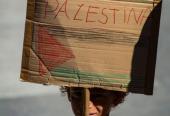Our Man in Havana. Who Was Alan Gross Working For?

Alan P. Gross, an American arrested in Cuba in 2009 for smuggling broadband satellite communications equipment, made world headlines on December 2014 when he was released the same day that US president Obama ordered the release of three Cubans who were in American prisons serving sentences for espionage. Press reports mentioned that Gross was in the Caribbean island in his capacity as a subcontractor for USAID, a US government agency that administers aid programs abroad. Throughout its history this agency has been accused of being an arm of US foreign policy and at worst a mere front for intelligence operations rather than the neutral and apolitical provider of aid to poor countries that it pretends to be. In 2014 USAID was caught red-handed in bizarre schemes to destabilize Cuba through Twitter and by funding hip hop artists.
A lesser known fact is that Gross was in Cuba working for a USAID contractor called Development Alternatives Inc. (DAI), a company that supervises and executes economic development projects all over the world. In 2010 it was USAID’s fifth biggest contractor, raking in almost $382.5 million in contracts just in that year.
DAI has also worked for the US State Department, the Pentagon, the World Bank, the United Nations, the European Commission, and private sector giants like Monsanto, Wal-Mart, Hewlett Packard, Sun Microsystems, Exxon Mobil, Daimler Chrysler, Unilever and The Gap.
“We tackle fundamental social and economic development problems caused by inefficient markets, ineffective governance, and instability”, says DAI about its work. “Since 1970, we have worked in more than 150 countries—delivering results across the spectrum of international development contexts, from stable societies and high-growth economies to challenging environments racked by political or military conflict.”
The company’s services include: corporate social responsibility, public-private partnerships, business strategy, exploration and analysis of market opportunities, integration of small businesses and small farmers into global value chains, food security and agribusiness promotion, financial services, drafting laws to make competitive economies, innovation and entrepreneurship, gender issues, climate change adaptation, carbon markets, water resources management, market environmentalism, legislative reform, citizen participation, public safety, health care, information and communications technology, and more. In short, if you want to set up a country from scratch, just call DAI.
According to Sourcewatch, a sort of Wikipedia of the left:
“DAI acted as a conduit for USAID (through the Office of Transition Initiatives) and National Endowment for Democracy (NED} funds to the Venezuelan opposition to president Hugo Chavez. Furthermore, it was instrumental along with NED affiliated organizations for financing black propaganda on Venezuelan private network TV during the general strike in 2002. Documents obtained through a Freedom of Information Act request show that DAI was required to keep certain personnel in Venezuela and had to consult with USAID about staff changes. Philip Agee, a former CIA officer, suggests that this is merely a cover for what passed for CIA operations in the past.”
The company’s own web site informs that it has played an important role in the United States’ geopolitical and military strategy in the Middle East:
“Following the 9/11 attacks of 2001 and the subsequent U.S. military actions, DAI was called on to lead a variety of challenging development projects in the midst of the counterinsurgency in Afghanistan, a country where we worked as early as 1977. Similarly, after the United States toppled the Iraqi regime in 2003, DAI won a project to help provide legitimate governance in the country. Other assignments in Iraq covered agriculture.”
It is most interesting that DAI would be in Afghanistan in 1977, way before the Soviet invasion, just when the CIA was arming and training an islamic fundamentalist insurgent force to destabilize the country.
According to a 2011 article in The Guardianby Jonathan Steele:
“Western backing for these (Afghan) rebels had begun before Soviet troops arrived. It served western propaganda to say the Russians had no justification for entering Afghanistan in what the west called an aggressive land grab. In fact, US officials saw an advantage in the mujahedin rebellion which grew after a pro-Moscow government toppled (Prime Minister) Daoud in April 1978. In his memoirs, Robert Gates, then a CIA official and later defence secretary under Presidents Bush and Obama, recounts a staff meeting in March 1979 where CIA officials asked whether they should keep the mujahideen going, thereby “sucking the Soviets into a Vietnamese quagmire”. The meeting agreed to fund them to buy weapons.”
Needless to say, this type of work can be pretty hazardous. In December 2009 five DAI employees were killed by an explosion in the USAID headquarters in Gardez, Afghanistan. From that facility DAI was running a Local Governance and Community Development project. According to DAI:
“Our mission on behalf of (USAID) was crucial: encourage communities in the most volatile parts of the country to turn away from the insurgency and toward the Government of the Islamic Republic of Afghanistan. We set out to do this in large part by facilitating 2,635 community projects that addressed local grievances, fostered stability, facilitated dialogue, and engendered trust in district and provincial leaders.”
The most notorious death of a DAI employee in a war zone was that of Linda Norgrove, who was abducted by the Taliban in eastern Afghanistan on September 2010. The US sent a Navy elite force to rescue her but the Rambo-style operation did not go well. Norgrove was killed, not by her captors but by a grenade thrown by one of her would-be rescuers, according to an official joint US-UK investigation of her death.
According to DAI CEO Jim Boomgard, Gross was in Cuba running a US government program called “Cuba Democracy and Contingency Planning Program”. In an August 2008 meeting, officials from this program told DAI representatives that “USAID is not telling Cubans how or why they need a democratic transition, but rather, the Agency wants to provide the technology and means for communicating the spark which could benefit the population.” The program, the officials said, intended to “provide a base from which Cubans can ‘develop alternative visions of the future.'”
In 2012 Gross and his wife sued USAID and DAI for allegedly not informing him adequately of the risk that his mission entailed – the case was settled out of court in 2013. If what Gross claimed in his lawsuit is true, then the man was an unwitting dupe in a US intelligence operation. It remains to be seen how many American aid workers who sincerely believed they were engaging in harmless, uncontroversial activity helping people abroad were actually being used by the CIA or other agencies as pawns in high risk games of political chess.













Add new comment